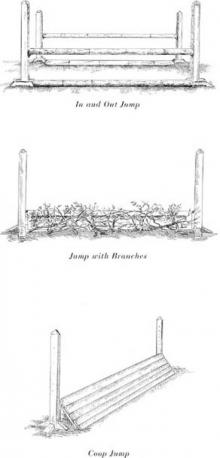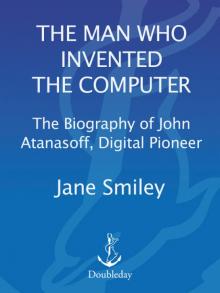- Home
- Jane Smiley
The Man Who Invented the Computer
The Man Who Invented the Computer Read online
Copyright © 2010 by Jane Smiley
All rights reserved. Published in the United States by Doubleday,
a division of Random House, Inc., New York, and in Canada
by Random House of Canada Limited, Toronto.
www.doubleday.com
DOUBLEDAY and the DD colophon are registered
trademarks of Random House, Inc.
Library of Congress Cataloging-in-Publication Data
Smiley, Jane.
The man who invented the computer : the biography of
John Atanasoff, digital pioneer / Jane Smiley.—1st ed.
p. cm.
1. Atanasoff, John V. (John Vincent) 2. Computer scientists—United States—Biography. 3. Inventors—United States—Biography. 4. Physicists—Iowa—Biography. 5. College teachers—Iowa—Biography. 6. Electronic digital computers—History—20th century. 7. Sperry Rand Corporation—History—20th century. 8. Patients—United States—History—20th century. 9. Intellectual property—United States—History—20th century. I. Title.
QA76.2.A75S64 2010
004.092—dc22
[B]
2010018887
eISBN: 978-0-385-53372-0
v3.1
Mathematical reasoning may be regarded rather schematically as the exercise of a combination of two faculties, which we may call intuition and ingenuity.
—Alan Turing, “Systems of Logic Based on Ordinals,” 1939
Contents
Cover
Title Page
Copyright
Epigraph
Introduction
Chapter One
Chapter Two
Chapter Three
Chapter Four
Chapter Five
Chapter Six
Photo Insert
Chapter Seven
Chapter Eight
Chapter Nine
Chapter Ten
Chapter Eleven
Chapter Twelve
Acknowledgments
Appendixes
Notes
Bibliography
About the Author
Introduction
The story of how the computer on my desk got to me is one of the most peculiar tales of the twentieth century, and it demonstrates many tropes often considered merely literary—peripeteia (a sudden reversal in the plot), hamartia (an error in judgment or a mistake), anagnorisis (unexpected recognition), catharsis (strong feelings), as well as significant amounts of tragedy, terror, and pathos, and even some comedy. Many characters took part, and they did, indeed, act in character—some were dedicated, brave, enterprising, and lucky. Others were hotheaded, deceptive, foolish, and unfortunate. All were brilliant, but the story of the computer shows how they were brilliant in different ways. At least one, the most sociable one, turns out also to have been the most mysterious but maybe the most pivotal. And oddly enough, no inventor of the computer got rich off the invention, even though a few tried.
The inventor of the computer was a thirty-four-year-old associate professor of physics at Iowa State College named John Vincent Atanasoff. There is no doubt that he invented the computer (his claim was affirmed in court in 1978) and there is no doubt that the computer was the most important (though not the most deadly) invention of the twentieth century. But on the MIT Inventor Archive, there is no “Atanasoff” between Barbara Askins (Method of Obtaining Intensified Image from Developed Photographic Films and Plates) and Mike Augspurger (Handcycle). Where and when did Atanasoff invent the computer? In a roadhouse in Rock Island, Illinois, while having a drink. He jotted his notes on a cocktail napkin.
At the time John Vincent Atanasoff conceived of his invention, he lived in Ames, Iowa, north of Des Moines, and taught in the physics department at Iowa State College (later to be renamed Iowa State University). He had been attempting to come up with a calculating machine since the early thirties, and he had tried all sorts of ideas. On that night in December 1937, frustrated that his work seemed stalled and baffling, he left his house on Woodland Street after supper and went back to his office in the physics building, but that was no good, either. So he jumped in his new car and headed for the Lincoln Highway—the two-lane road that was the first highway to connect the East Coast with the West Coast (Times Square in New York with Lincoln Park in San Francisco). Atanasoff drove east for some sixty or seventy miles, through the flat prairies of Story County and Marshall County, to Tama, then he turned southeast toward Marengo. He drifted past Iowa City on Highway 6. The landscape of eastern Iowa was rolling and forested—decidedly different from the flatlands around Ames. He drove rather fast, and so his trip demanded concentration and was a relief from his recent obsessive focus on his computing problem.
Atanasoff later recalled, “I had reached the Mississippi River and was crossing into Illinois at a place where there are three cities … one of which is Rock Island. I drove into Illinois and turned off the highway into a little road, and went into a roadhouse, which had bright lights … I sat down and ordered a drink … As the delivery of the drink was made, I realized that I was no longer so nervous and my thoughts turned again to computing machines.”
The youthful professor came up with four ideas about how a computer might work. They came to him all at once—four parts of a system that he had not been able to get a handle on in the previous five to seven years of concentrated effort. After he finished his drink (or two, though his son later maintained that more than one drink tended to put him to sleep, and that he had been known to stretch out on the carpet at parties after two), he got back into his car, drove home, and set about working out his ideas in detail. Within two years, he and a graduate student named Clifford Berry had constructed a working prototype at a cost of $650 ($450 to pay his assistant and $200 for materials).
If this sounds like the American dream, it is—Atanasoff’s invention of the computer came about as a result of immigration to the United States from a troubled area, internal migration around the United States in search of better opportunities, and a system of general, and inexpensive, public education that was based upon the land-grant universities established by the Morrill Act of 1862. Atanasoff’s American dream also included wholesome family values, innovative genius, and, eventually, vindication, but the path from those notes written on a napkin in Rock Island to this computer on my desk was a tortuous one. The story of the invention of the computer is a story of how a general need is met by idiosyncratic minds, a story of how a thing that exists is a thing that could have easily existed in another way, or, indeed, not existed at all.
But although this volume is a biography of Atanasoff and focuses on him, his story can only be told in the context of other stories, because in that December of 1937, others too were pondering the difficulties of calculation. Alan Turing, a visiting fellow at Princeton, was wondering if the Liverpool tide-predicting machine, a system of pulleys and gears used to measure and predict tides on the river Mersey, could serve as a core idea for a general calculating machine. Tommy Flowers, an engineer at the General Post Office outside London, was wondering if vacuum tubes (or “valves” as they were called in England) could be used for telephone system relays. Max Newman, a Cambridge mathematician, was nervous about what was going on in Europe but hadn’t turned his thoughts to computers yet. John Mauchly, aged thirty, was teaching at Ursinus College in Pennsylvania—his passion was weather prediction, and he had his students attempting to find mathematical correlations between U.S. rainfall and patterns of solar rotation. J. Presper Eckert, only eighteen, was applying to college at MIT, though in the end he went to business school at the University of Pennsylvania. Konrad Zuse, in Berlin, had already built one computer (the Z1) in his parents’ ap
artment. He later said that if the building had not been bombed, he would not have been able to get his machine out of the apartment. John von Neumann, born in Hungary but living in Princeton, New Jersey, had become so convinced that war in Europe was inevitable that he had applied for U.S. citizenship. He received his naturalization papers in December 1937. Von Neumann was one of the most talented mathematicians of his day, but he wasn’t yet involved with computers. It is the weaving of these individual stories that makes up the whole story and causes it to become not merely the tale of an invention, but a saga of how the mind works, and of how the world works.
Atanasoff invented the computer as a labor-saving device. In 1930, when he was studying quantum mechanics at the University of Wisconsin, he decided to do his doctoral thesis on using a quantum mechanical method of calculating the capacity of helium to reduce the intensity of an applied electric field relative to that in a vacuum. His dissertation, only ten pages long, involved weeks of arithmetic on a heavy metal desk calculator with a hundred typewriter-like keys designed to perform addition and subtraction (multiplication and division were performed through repeated additions or subtractions). Atanasoff found performing the calculations extremely laborious, and when he began teaching the following year, he realized that his students were trapped in the same tedious difficulty—by the 1930s, solving mathematical equations with large numbers of variables was becoming a serious obstacle to progress not only in education and science, but also in industry, government, and the military. In 1940, Atanasoff estimated that it would take a person 8 hours to solve eight equations with eight unknowns, 125 hours for twenty equations and twenty unknowns. Another computer scientist for Bell Labs suggested in 1948 that there was “a practical limitation on the size of systems to be solved … It is believed that this will limit the process used, even if used iteratively, to about 20 or 30 unknowns.” The problem was a product of increasing knowledge about how numbers work, how the world works, and how the one might be applied to the other. It was likewise the product of industrialization and modernization, of hundreds of years of ingenuity and the inventions and the observations and theories that ingenuity permitted.
Each of the inventors I will discuss in this volume had different motives for turning his thoughts to ideas of a new variety of machine, and the genius of each was idiosyncratically formed by temperament, education, family history, by restrictions as well as by opportunities. In some ways, Alan Turing was Atanasoff’s precise opposite, drawn to pure mathematics rather than practical physics, educated to think rather than to tinker, disorganized in his approach rather than systematic, never a family man and required by his affections and his war work to be utterly secretive. His figure is now so mysterious and tragically evocative that he has become the most famous of our inventors. The man who was best known in his own lifetime, John von Neumann, has retreated into history, more associated with the atomic bomb and the memory of the cold war than with the history of the computer, but it was von Neumann who made himself the architect of that history without, in some sense, ever lifting a screwdriver (in fact, his wife said that he was not really capable of lifting a screwdriver). It is von Neumann for whom partisans of John Mauchly and J. Presper Eckert reserve their greatest wrath—with some justification—but Mauchly and Eckert have their own story of imagination, ambition, and disappointment, all of which grew out of their characteristic ways of thinking and doing. Perhaps the oddest duck in our gallery of odd ducks was Konrad Zuse, whose work on the computer can only be described as an adventure of the most daring kind. Zuse was two years older than Turing, born in Berlin but reared in a small town in East Prussia and lured into computer design not out of a passion for numbers or a pedagogical desire to advance mathematical computation but through an interest in art and design. Zuse conceived and built his computer without any contact with the world outside of Germany or even Berlin, and under the most adverse of circumstances. It is as if we have several movies running simultaneously—a sunlit-apple-pie-American-progress movie in one theater, a noirish tale of cold war deception, paranoia, and intrigue in the theater next door, a version of Mrs. Miniver crossed with a spy movie set in the blacked-out streets of London in a third, and, as a bonus in the fourth theater, a terrifying German resistance film, set in a collapsing Berlin, but with a happy ending.
The great event all these films share is World War II. In his recent volume of essays, historian John Lukacs catalogs the ways in which, seventy years later, World War II is still shaping the world we live in, even though all the power relationships and ideologies then in play, among the Allies and the Soviet Union and Hitler’s Germany, have shifted utterly. In the index of Lukacs’s book, no mention is made of the computer. But, as we will see, the Second World War was the sine qua non of the invention of the computer and the transformation of the nature of information and the nature of human thought that the computer age has brought about. However, we begin with another war, a small war in a place very far removed from Rock Island, Illinois.
Chapter One
John Vincent Atanasoff’s father, Ivan, was born in 1876, in the midst of a period of climaxing political unrest. His parents were landed peasants in the Bulgarian village of Boyadzhik (about eighty miles from the Black Sea and perhaps halfway between Istanbul and Sofia). The Ottoman Empire was breaking up—Serbia had won independence in 1830 and Greece in 1832. Revolutionary agitation in Bulgaria, which intensified in the 1870s, culminated in the April Uprising of 1876, in which bands of Christian resistance fighters attacked Ottoman government offices and police enclaves. The attacks were followed by a campaign of reprisal on the part of the Ottoman government. Ivan’s father, Atanas, and his mother, Yana, were forced to flee their village, Atanas carrying the baby Ivan in his arms. In the course of the melee, Yana was knocked unconscious and Atanas was shot in the back. The bullet killed Atanas and creased the baby’s scalp as it exited through his father’s chest, but Ivan and Yana survived (though American translator Eugene Schuyler estimated from his own observations at the time that fifteen thousand Bulgarians were killed, and five monasteries and fifty-eight villages—including Boyadzhik—were destroyed in these attacks). The revolution was put down for the time being and the Ottoman response was widely publicized and deplored, and then in mid-1877, Russia attacked the Ottoman Empire in the Balkans with the express purpose of liberating the Balkan Christian states and regaining access to the Black Sea that Russia had lost in the Crimean War. The conflict was short—the autonomy of Bulgaria was recognized in the Treaty of San Stefano, signed on March 3, 1878. Among the Russian cheerleaders for the war were Ivan Turgenev, who thought Bulgaria should be liberated, and Fyodor Dostoyevsky, who hoped to unite all Eastern Orthodox churches under the Russian church.
Yana subsequently married a local cattle breeder who could afford to educate little Ivan, while her brother made contact with American missionaries, who helped him get to America. When this uncle returned on a visit to Bulgaria in the late 1880s, young Ivan, now thirteen, decided to go back to America with him. Yana financed the trip by selling a piece of land that Atanas had left her.
At Ellis Island, Ivan Atanasov’s name was changed to John Atanasoff. Although he had a bit of money, it was only enough to rent a room in New York City so that he could work at a series of menial restaurant and handyman jobs while he improved his English. Life was difficult and jobs were scarce, though he did manage to keep a chicken in his room for a while. A charitable local minister he met through his uncle found him a place as a student at the prestigious Peddie School, in Hightstown, New Jersey (not far from Princeton), where he worked hard and did well, but upon graduation, his education at first seemed to be of little use—his uncle had returned to Bulgaria, and there were no more family funds forthcoming. He was homeless for a while, working temporary jobs, but then he related his tale to a Baptist minister named Cooke, who encouraged him to seek the aid of various local congregations. Once he had accumulated $200 in savings and gifts, Pastor Cooke helped him f
ind a spot at Colgate, at that time a Baptist-affiliated college.
At Colgate, John met the sister of two brothers who were fellow students, a girl named Iva Purdy, a descendant of early settlers in Connecticut and generations of farmers in upstate New York. Iva, herself a high school graduate with a talent for mathematics, was teaching in a nearby school. After courting Iva, John married her at Christmas 1900 and then graduated from Colgate the following June. John Vincent was born on October 4, 1903.
Although John had taken his degree in philosophy, he found work in industrial engineering at the Edison power plant in Orange, New Jersey. When work at the plant (possibly chemicals used in the manufacture of lightbulbs) seemed to be adversely affecting his health, he moved on to the power plant in Utica, New York, then to the Delaware, Lackawanna, and Western Railroad electrical plant in Hoboken, New Jersey. At night, he took correspondence courses in electrical engineering. Four children had been born by the time John Vincent was nine—two who lived and two who died in infancy. John and Iva came to feel that the family was not thriving because, in addition to John’s own respiratory problems, the children were suffering repeated bouts of illness. They decided to move to the newly founded town of Brewster, Florida, on the west coast, some thirty miles as the crow flies southeast of Tampa, where American Cyanamid was in the process of exploiting local phosphate deposits. John got a good job, and the children’s health improved. John Vincent attended school at the local two-room schoolhouse.
Iva Atanasoff gave her oldest child considerable freedom, both of action and of thought, in part because other children were born in Florida (eventually there were seven) and she oversaw a large garden in addition to the household. But Iva also retained her interest in intellectual pursuits—according to family stories, she liked to sit in her rocking chair and read while John and his younger brothers and sisters played about her. By the time young John got to school, he already knew how to read and calculate, and at first he was a difficult pupil—he was used to following his own agenda. Since he had no trouble doing his work, he finished ahead of the other children, and once he had done so, he made himself a “pest,” according to his younger sister. But he was an inconvenient pupil also because he was inquisitive and knew more than many of his teachers. He was easily offended, especially by teasing and slurs, and he didn’t mind getting into fights. Some teachers handled him well and some did not, but however they handled him, his pronounced eagerness to learn persisted—he eagerly explored both the countryside and whatever books he could get hold of.

 The Georges and the Jewels
The Georges and the Jewels Pie in the Sky: Book Four of the Horses of Oak Valley Ranch
Pie in the Sky: Book Four of the Horses of Oak Valley Ranch Duplicate Keys
Duplicate Keys Charles Dickens
Charles Dickens Good Faith
Good Faith Private Life
Private Life A Thousand Acres: A Novel
A Thousand Acres: A Novel The Greenlanders
The Greenlanders Ten Days in the Hills
Ten Days in the Hills Gee Whiz: Book Five of the Horses of Oak Valley Ranch
Gee Whiz: Book Five of the Horses of Oak Valley Ranch A Thousand Acres
A Thousand Acres The All-True Travels and Adventures of Lidie Newton
The All-True Travels and Adventures of Lidie Newton Ordinary Love and Good Will
Ordinary Love and Good Will Taking the Reins (An Ellen & Ned Book)
Taking the Reins (An Ellen & Ned Book) The Man Who Invented the Computer
The Man Who Invented the Computer Horse Heaven
Horse Heaven The Age of Grief
The Age of Grief Riding Lessons
Riding Lessons Perestroika in Paris
Perestroika in Paris A Good Horse: Book Two of the Horses of Oak Valley Ranch
A Good Horse: Book Two of the Horses of Oak Valley Ranch Saddles & Secrets (An Ellen & Ned Book)
Saddles & Secrets (An Ellen & Ned Book) Some Luck: A Novel
Some Luck: A Novel Champion Horse
Champion Horse Some Luck
Some Luck Gee Whiz
Gee Whiz Barn Blind
Barn Blind A Thousand Acres (1992 Pulitzer Prize)
A Thousand Acres (1992 Pulitzer Prize) Pie in the Sky
Pie in the Sky True Blue
True Blue A Thousand Acres_A Novel
A Thousand Acres_A Novel A Good Horse
A Good Horse